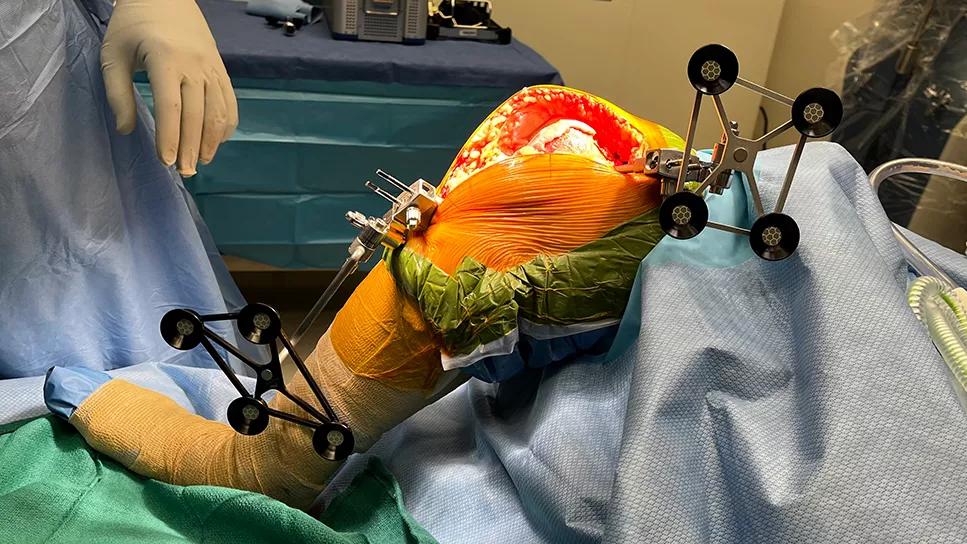Study finds that fracture and infection are rare

Up to one in two total knee arthroplasty (TKA) procedures will use robotic arm assistance by 2030, according to projections. During typical robot-assisted surgeries, bone array pins are affixed to the femur and tibia via small incisions outside the primary incision. These extraincisional pin placements may be associated with higher risk of infection and fracture.
Advertisement
Cleveland Clinic is a non-profit academic medical center. Advertising on our site helps support our mission. We do not endorse non-Cleveland Clinic products or services. Policy
In an attempt to decrease the rate of complications like these, an alternative technique has been adopted at Cleveland Clinic, which recently celebrated its 10,000th robot-assisted total joint replacement.
“We’ve been mastering the technique of placing the pins within the main incision,” explains Nicolas S. Piuzzi, MD, Director of Cleveland Clinic Adult Reconstruction Research. “This has become our standard of care.”
Because, in the past, this intraincisional approach was off label for some robotic platforms, there is limited evidence for its use.
“We wanted to complement our experience with data so that we can support our practice with evidence,” says Dr. Piuzzi.
The resulting study, published in The Journal of Arthroplasty, assessed the safety and complication profile of intraincisional pin placement in TKA.
The study analyzed data from more than 2,300 patients who had robot-assisted TKA at Cleveland Clinic from 2018 to 2022. All the surgeries involved a standard anterior midline incision with a medial parapatellar approach to the knee. Two metaphyseal tibial pins and two metaphyseal femoral pins were placed intraincisionally with varying locations and methods.
Out of the patients studied, three (0.13%) experienced periprosthetic fractures. One of the three patients had a pin-site fracture in the anterior tibia intraoperatively. The other two patients experienced fractures postoperatively, one a pin-site fracture in the femur and the other a patellar fracture.
All patients presented for their 90-day follow-up. Besides the two patients who had pin-site-related periprosthetic fractures, 33 patients (1.4%) had either superficial or deep infections.
Advertisement
Of the 1,655 patients who had a one-year follow-up, 29 (1.8%) underwent reoperation, most for deep infection (n = 14) or superficial infection (n = 3).
Overall, the evidence showed that only 1 in 1,172 patients developed a pin-related periprosthetic fracture after robot-assisted TKA using intraincisional pin placement. In addition, the rate of infection at 90 days and the rate of reoperation at one year were very low.
“Major complications were extremely rare in this study, which indicates that intraincisional pin placement is a safe technique and completely scalable,” says Dr. Piuzzi.
Intraincisional pin placement should not be attempted in patients who have retained hardware or who have an abnormal anatomy. In these patients, pins should be placed in a traditional, extraincisional fashion, he notes.
Yet, in most patients, the placement of intraincisional pins expedites surgery, making it more efficient with fewer incisions.
“Now we have evidence backing this approach, which may encourage other surgeons to use it too,” Dr. Piuzzi concludes.
Advertisement
Advertisement

As robotics in the OR grows, so does the role of nurses

Cleveland Clinic orthopaedic surgeons share their best tips, most challenging cases and biggest misperceptions

Enhanced visualization and dexterity enable safer, more precise procedures and lead to better patient outcomes

Multidisciplinary care can make arthroplasty a safe option even for patients with low ejection fraction

Cleveland Clinic is among the first in the U.S. to perform the procedure

Minimally invasive pancreas-kidney replacement reduces patient’s pain, expedites recovery

Self-care may be just as effective for some patients

Most return to the same sport at the same level of intensity